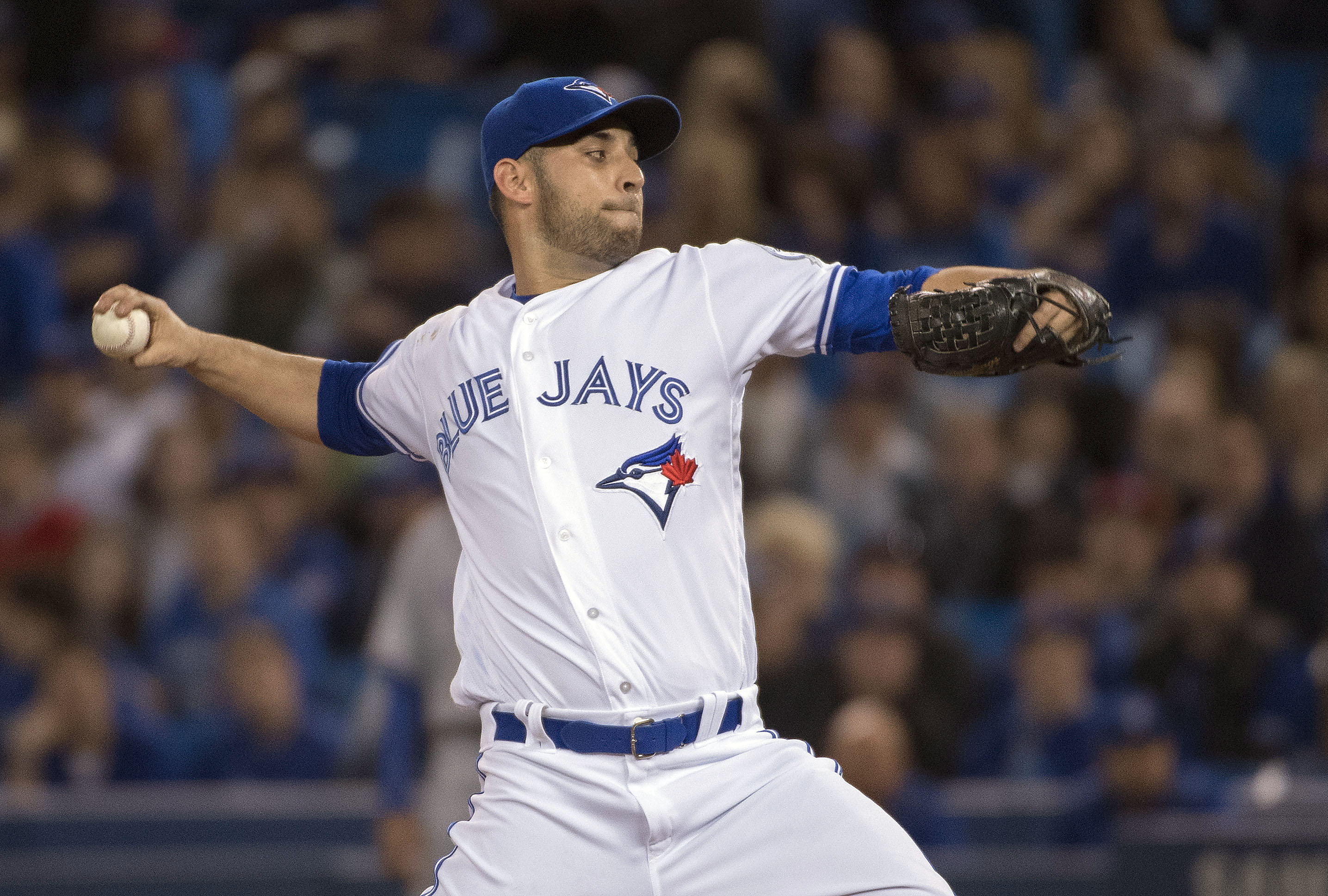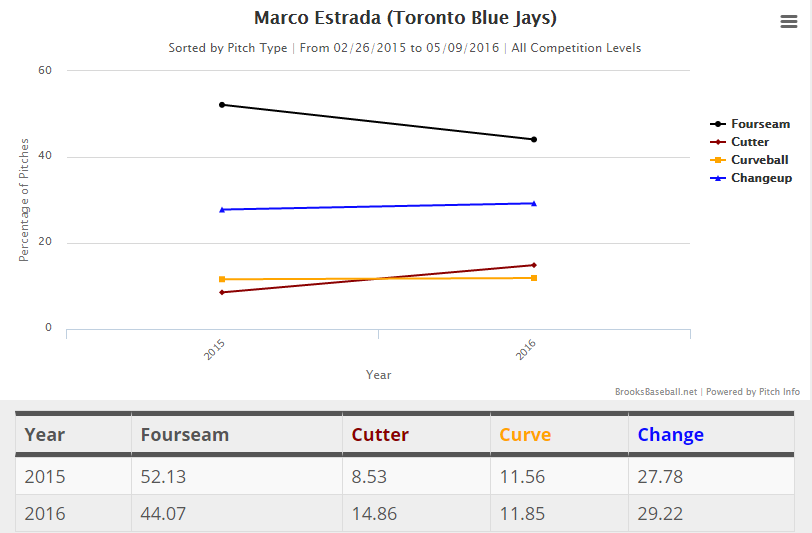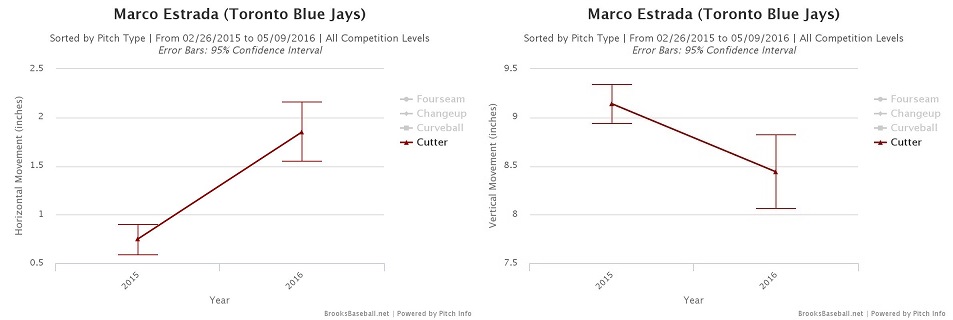Coming into the season, much of the talk surrounding the Toronto Blue Jays was based around the volatility in the starting rotation, with most people reasonably secure with the bullpen and the offense. Well, in the early parts of 2016, the truth has been anything but. The lineup has really struggled at times, and the bullpen has allowed nearly half of all inherited runners to score. On the flip side, the starting pitching has been nothing short of excellent. They lead the league in innings pitched and sit fourth in the AL with a 3.47 ERA.
One of the men who most embodies this flip from expectations is last year’s staff ace, Marco Estrada. 2015 was a magical year for the former Brewer, as he finished fifth in ERA, second in WHIP, and first in opponents batting average. However, coming into this year, many expected regression from the 32-year-old. He had never been as successful as he was in 2015, and it came on the back of a a .216 BABIP. With that said, there were reasons to believe that some of the success would be sustainable. Still, even those who believed in his changes, as I did, expected at least a small step back.
A big part of why many expected that return to “normalcy” from Estrada was the departure of his personal catcher, Dioner Navarro. Navarro is known around the league as an elite pitch caller, and he drastically changed the pitch usage of both Estrada and Mark Buehrle, to tremendous success. Also, like Buehrle, Estrada no longer shakes off his catcher (which he actually learned from the veteran lefty). He just gets the sign and throws the pitch.
Of course, Russell Martin is no slouch when it comes to calling a game. He takes pride in his work with pitchers, and when I spoke to Estrada back in spring training, he mentioned that both Martin and Pete Walker had studied what made Estrada so successful last year with an eye to helping it extend into 2016 and beyond.
So far it’s pretty clear that things are working. Estrada has actually lowered his ERA by almost 3/4 of a run, while also increasing his strikeout rate to 23.7 percent. It sounds like he has picked up right where he left off. Well…sort of. It’s not nearly as drastic as what happened with J.A. Happ, but Marco Estrada has made some alterations to his work from last year. This is something that we probably could’ve seen coming. From that same Estrada conversation piece I linked above:
“Of course, Estrada isn’t done trying to get better just because he seems to have acquired this zen-like trust in his catcher. Like any great athlete, Estrada is always striving to adapt so that he can be the best. He learned his now famous changeup in the minors (from Clint Everts) when he realized he didn’t have enough of a repertoire to get pro hitters out. Then, just last year Estrada added his current cutter, which he now feels comfortable throwing in any count.”
It also just so happens that the first obvious difference comes right out of that very paragraph. Take a look at Estrada’s pitch rates for this season.
One thing jumps out right away: Estrada has started throwing a lot more cutters, at the expense of his fourseam fastball. At first glace, this might seem like an odd decision. After all, last year, batters hit .323/.333/.613 on plate appearances that ended with the cutter. Well, he has refined the pitch this year and, it has taken a complete turn. Batters are hitting just .143 with zero extra base hits, and he has increased the whiff rate from 8.3 percent up to 19.2 percent.
Perhaps most importantly, the cutter has turned into a pitch that helps Estrada get groundballs. As we all know too well, Marco Estrada is an extreme flyball pitcher (or popup pitcher, as he prefers to be called), but sometimes a groundball is needed to get out of a jam. That’s where the cutter comes in. Last year Estrada was getting groundballs on 37 percent of his cutters. This year, that number is 57.9. As a result, his overall groundball rate on every pitch has risen from 32.2 percent last year up to 42.6 percent so far in 2016.
So why has this happened? Well, here’s one reason:
As you can see, Estrada is getting a full inch extra of horizontal movement, and about three-quarters of an inch of extra drop (higher numbers mean the piece is fighting gravity, or staying up, more). That would certainly help generate more missed swings and more grounders.
That’s definitely a huge factor in Estrada’s success so far, but it’s still one of his most infrequently thrown pitches (just ahead of the curveball). Marco Estrada makes his money on his fastball and changeup. The change is almost exactly the same as last year, both in movement and location, so there’s not much to say on that subject. It is one of the best changeups in baseball, so there is no clear need to tinker. On the fastball, however, it’s a completely different story.
Last year, Marco Estrada started throwing his fastball up in the zone for the first time in his career. When combined with his elite spin rate, it caused batters to pop up the ball a ton. This year, he is doing things a little bit more traditionally.

He is still getting elite rise, with his fastball actually dropping less, at 12.9 inches compared to 12.4 inches last year, but he is no longer using it at the top of the zone with the goal of getting easy popups. Instead, he is aiming for weak contact overall on the black of the plate, which is more traditional for a pitcher with an 89 mph fastball.
This is helping with the increased groundball rate, but it also helps explain some of the other ratio changes. By working to the edges with the heater, Estrada gets more swings and misses (17.4 percent this year compared to 15.5 percent last year), but more significantly, he gets fewer swings overall. Last year, batters offered at 48.5 percent of Estrada’s fastballs. This year, that number is down to 42.8 percent. He is also throwing fewer of them in the strike zone, at 49.8 percent down from 51.8. As a result, the walks have gone up slightly. Still, with less consistent and weaker contact, it’s a pretty logical tradeoff.
Like Happ, however, once Estrada gets to two strikes, his approach changes considerably.
With his offspeed stuff, Estrada tries to pound the lower part of the zone in zero or one strike counts, but goes down and out of the zone with two strikes. Similarly, he works the fringes of the zone with his fastball and cutter until he gets to a strikeout situation, where he works heavily to the upper part of the zone and off the plate to his arm side. When you combine all of these approaches with Estrada’s devastating changeup, you get more groundballs, more strikeouts, and yes, more walks. Overall, you get the type of performance that we have seen so far this year.
At least in the short term, the Navarro factor seems to have been overstated. Russell Martin isn’t doing things the same way, but he has made adjustments that are more than paying off for the Marco Estrada. Martin doesn’t get all the credit, of course. Estrada also did great work refining his cutter, and has had to execute the pitches Martin is putting down.
It’s obviously still early in the season, as Estrada has made only six starts so far, so I will be checking back in twice more to see how things keep up. I will do it once around the all-star break and once more at the end of the season. However, I don’t really expect things to change. Russell Martin is an elite catcher, and Marco Estrada is showing that among starting pitchers, he is one of the best bargains in major league baseball.
Lead Photo: Nick Turchiaro-USA TODAY Sports
Pitch Charts Courtesy of Brooks Baseball




